Physical Address
304 North Cardinal St.
Dorchester Center, MA 02124
Few groups of tumors can show such a broad spectrum of morphologic appearances and clinical behavior as vascular tumors. Classification is a problem not only because the line between neoplasia and malformation (or so-called hamartoma) remains undefined, but also, and more importantly, because it is frequently difficult to distinguish benign from malignant lesions. It is interesting that in comparison with other soft tissue tumors (see Chapter 24 ), cytogenetic and molecular genetic analysis was much slower to have impact because of the difficulty in culturing these lesions, but newer technologies have changed this dramatically in the past 5 years. In this chapter, an updated classification of vascular tumors is used, including recently described entities and reclassification of some better known entities in the light of recent developments in the understanding of their biology ( Box 3.1 ). Emphasis is placed on lesions presenting in soft tissue and skin as vascular tumors are more common in these locations. Distinctive vascular tumors in other organs are dealt with in the appropriate chapters.
Reactive vascular proliferations
Papillary endothelial hyperplasia (Masson tumor)
Reactive angioendotheliomatosis
Glomeruloid hemangioma
Papillary hemangioma
Bacillary angiomatosis
Vascular ectasias
Nevus flammeus (salmon patch, port-wine stain)
Nevus araneus
Venous lake
Angioma serpiginosum
Hereditary hemorrhagic telangiectasia (Osler-Weber-Rendu syndrome)
Angiokeratoma
Capillary hemangioma (including congenital hemangiomas)
| Variants: | Tufted angioma |
| Verrucous hemangioma | |
| Cherry angioma | |
| Lobular hemangioma (pyogenic granuloma) |
| Variant: | Sinusoidal hemangioma |
| Variants: | Superficial (cirsoid aneurysm) |
| Deep |
Microvenular hemangioma
Hobnail (targetoid hemosiderotic) hemangioma
Acquired elastotic hemangioma
Cutaneous epithelioid angiomatous nodule
Epithelioid hemangioma (angiolymphoid hyperplasia with eosinophilia)
Venous hemangioma
Spindle cell hemangioma (hemangioendothelioma)
Symplastic hemangioma
| Variants: | Intramuscular |
| Synovial | |
| Intraneural | |
| Anastomosing |
Angiomatosis
Locally aggressive
Kaposi-like hemangioendothelioma
Giant cell angioblastoma
Rarely metastasizing
Retiform hemangioendothelioma
Malignant endovascular papillary angioendothelioma (Dabska tumor)
Pseudomyogenic hemangioendothelioma
Composite hemangioendothelioma
Polymorphous hemangioendothelioma
Kaposi sarcoma
| Variants: | Lymphangioma circumscriptum |
| Cavernous lymphangioma/cystic hygroma | |
| Benign lymphangioendothelioma (acquired progressive lymphangioma) |
Lymphangiomatosis
Lymphangiomyoma
Lymphangiomyomatosis
Multifocal lymphangiomatosis with thrombocytopenia
Kaposiform lymphangiomatosis
Atypical vascular proliferation after radiotherapy
Intravascular papillary endothelial hyperplasia is a relatively common reactive condition representing an unusual form of organizing thrombus. It presents in three different settings: (1) as a pure form involving an isolated dilated blood vessel (primary); (2) as a focal change in a variety of preexisting vascular lesions including hemangiomas, hemorrhoidal veins, and varices (secondary); and (3) although rare, in an extravascular location in association with a hematoma. Trauma does not appear to be related consistently to any of these forms. In the primary type the lesion typically presents as an asymptomatic bluish nodule in the finger or head and neck region of young adults; no sex predilection is seen. Presentation in the breast has also been described, and in this setting distinction from angiosarcoma may be difficult. The phenomenon can also be seen in internal organs, mainly the upper respiratory and gastrointestinal tracts, but it is rare. Lesions are generally less than 2 cm in diameter, and, after excision, recurrence is rare. Multiple lesions are uncommon and have been described exceptionally in association after treatment with interferon-β. When papillary endothelial hyperplasia arises in a preexisting vascular lesion, clinical findings are related to the primary vascular abnormality and lesions tend to be larger. These secondary lesions theoretically can present in any vascular tumor and at any anatomic site but are particularly common in association with deep-seated hemangiomas, especially of the cavernous type.
Primary forms appear as well-circumscribed hemorrhagic lesions, which on closer examination reveal a preexisting dilated vascular space, most commonly a thin-walled vein. The appearances of secondary cases depend on the nature of the preexisting primary lesion. In extravascular lesions no obvious vascular structure is identified even after serial sectioning. All forms are typified by the presence of multiple small papillary structures, covered by a single layer of attenuated endothelial cells showing little or no atypia ( Fig. 3.1 ). Mitoses are usually absent. The papillary core is composed of hypocellular, hyaline collagen with occasional small capillaries. In the earliest lesions, papillae appear to be composed of fibrin. Although most papillae seem to be lying free in the vascular lumina, some of them appear to be attached to the vascular wall. Numerous red blood cells surround the papillae, and usually associated thrombus is seen, which may be organized to a variable degree; at the edge of the thrombus one may identify the early stages of the formation of fibrinoid papillae.
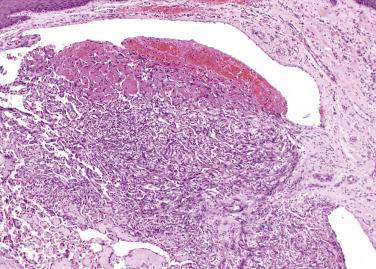
Angiosarcoma occurs in a different clinical setting and is generally an extravascular process characterized by an infiltrative or dissecting growth pattern, moderate to prominent cytologic atypia, endothelial multilayering, and mitotic activity.
Until the early 1980s, angioendotheliomatosis was traditionally classified into malignant and benign variants, which were thought, in some cases, to be difficult to separate from each other on clinical and histologic grounds. However, it became clear that the malignant variant is a systemic angiotrophic lymphoma (associated with a poor prognosis; see Chapter 21 ), not related at all to the reactive variant that is truly endothelial, often self-limiting, and generally confined to the skin. Clinically, reactive angioendotheliomatosis is a very rare condition that presents as erythematous macules, papules, or plaques, which can be associated with petechiae and ecchymoses and more rarely with a livedo-like pattern. It has no age predilection, and most cases occur in adults, children being only exceptionally affected. It can be idiopathic or associated with a wide range of systemic diseases including paraproteinemia, renal disease, amyloidosis, antiphospholipid syndrome, rheumatoid arthritis, cirrhosis, polymyalgia rheumatica, sarcoidosis, myelodysplastic syndrome, and a well-differentiated angiosarcoma, although the latter may have been coincidental. A rare case presenting after administration of trabectedin and pegfilgastrim has been described. However, the association with systemic disease, particularly bacterial endocarditis, is not as strong as previously believed. A variant of reactive angioendotheliomatosis has been described as angiomatosis with luminal cryoprotein deposition in patients with cryoglobulinemia. The clinicopathologic spectrum of the disease has been expanded to include rare localized forms of the disease, including a variant associated with peripheral vascular atherosclerotic disease and iatrogenic arteriovenous fistulas, described as diffuse dermal angiomatosis. The latter has been described in the breast of female patients and is associated with macromastia, obesity, and smoking. These lesions might be a consequence of ischemia and may also be seen in obese patients in areas with prominent subcutaneous tissue.
The histology is variable. In the dermis and superficial subcutis, multiple clusters of closely packed capillaries are often seen ( Fig. 3.2 ) lined by larger than normal endothelial cells, which show no cytologic atypia and are surrounded by pericytes. Many cases have a rather lobular architecture. These endothelial cells may occlude the vascular lumina, but no multilayering exists. Focal extravasation of red blood cells and occasional fibrin thrombi are also seen. Adjacent dermis shows mild chronic inflammation, sometimes associated with fasciitis-like changes. In angiomatosis with luminal cryoprotein deposition, many capillaries appear occluded by refractile eosinophilic thrombi. In diffuse dermal angiomatosis, proliferation of poorly canalized capillaries is seen.
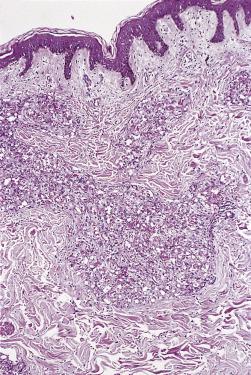
Glomeruloid hemangioma is a distinctive reactive vascular proliferation that occurs in patients with multicentric Castleman disease and POEMS (polyneuropathy, organomegaly, endocrinopathy, M protein, skin changes) syndrome. Clinically, patients present with numerous cutaneous angiomas, which on histologic examination can show features of cherry angioma or, less frequently, those of glomeruloid hemangioma. The cutaneous angiomas can be the first manifestation of the disease. Histologically, multiple dilated vascular spaces are seen, especially in the superficial dermis, and these contain in their lumina clusters of capillaries with a striking resemblance to renal glomeruli ( Fig. 3.3 ). Around the capillaries are pericytes and larger cells with clear cytoplasm and occasional periodic acid–Schiff (PAS)–positive hyaline globules, probably representing deposits of immunoglobulin. However, by electron microscopy the inclusions appear to represent enlarged secondary lysosomes (thanatosomes). These large cells are positive for endothelial markers. Human herpesvirus 8 (HHV-8) has not been detected in lesions of glomeruloid hemangioma. Solitary lesions with histologic features of glomeruloid hemangioma have been documented. These lesions may be related to the recently described papillary hemangioma (see later discussion).
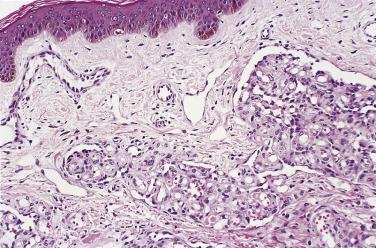
Papillary hemangioma is a recently described cutaneous vascular lesion that presents as a long-standing papule on the head and neck of adults, with predilection for men. Local recurrence is exceptional. Histologically it is characterized by dermal dilated, thin-walled vascular spaces with papillary projections containing pericytes and thick basement membrane–like material and lined by plump nonatypical endothelial cells. The latter contain numerous cytoplasmic eosinophilic globules. It has been suggested that these lesions represent a variant of solitary glomeruloid hemangioma and that the inclusions as in the latter represent giant lysosomes with cellular debris and fat vacuoles (thanatosomes). Papillary hemangioma, however, lacks a glomeruloid architecture and contains thick basement membrane–like material and pericytes in the papillary projections.
As opposed to true hemangiomas, vascular ectasias do not show an increase in the number of blood vessels, but rather they are composed of dilated preexisting normal blood vessels. However, some vascular ectasias may be associated with an underlying cavernous hemangioma or arteriovenous malformation. Vascular ectasias include nevus flammeus (port-wine stain and salmon patch), spider nevus (nevus araneus), venous lakes, angioma serpiginosum, and angiokeratomas.
Nevus flammeus includes salmon patch and port-wine stain. Both lesions are also known as the common birthmark and may occur in as many as 50% of infants. The salmon patch is characterized by a red-pink macule, located in the head and neck area, which tends to involute with time. In a study of cutaneous findings in hospitalized neonates, a salmon patch was found in 91.2% of patients. By contrast, the port-wine stain, now recognized as a vascular malformation, shows progressive growth with no tendency to regress and can acquire an elevated surface. Most lesions are congenital, but rare acquired cases have been documented, including a case presenting after trauma. Familial cases also occur, and in such cases the gene has been mapped to chromosome 5q. Port-wine stains may be associated with vascular malformations of the meninges, brain, or retina in Sturge-Weber syndrome and with limb hypertrophy, varicosities, and partial venous agenesis in Klippel-Trénaunay syndrome. If the latter is associated with an arteriovenous fistula, it is known as Parkes Weber syndrome. Other vascular lesions, particularly pyogenic granuloma and, exceptionally, tufted angioma, may occur within a port-wine stain. Both symdromic and nonsyndromic port-wine stains are known to be caused by activating somatic mutations in GNAQ . Histologically, both conditions show ectatic dermal blood vessels of differing size ( Fig. 3.4 ), with usually deeper subcutaneous involvement in the port-wine stain.
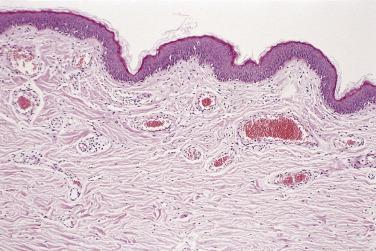
Spider nevi are very common acquired lesions. They present over a wide age range as tiny, red, pinhead papules from which tortuous blood vessels radiate. They are commonly associated with pregnancy, chronic liver disease, and hyperthyroidism. Typical histologic findings are the presence of a thick-walled, dilated arteriole in the superficial dermis communicating with several anastomosing capillaries.
Venous lakes are common vascular ectasias that occur in elderly people; sun-exposed areas are affected, especially the face, with predilection for the lips and ears. Histologically, a markedly dilated and congested vein is seen in the superficial dermis and is surrounded by an irregular layer of smooth muscle.
Angioma serpiginosum is an uncommon, slowly progressive lesion that mainly affects the lower limbs of children, especially girls. It presents as tiny punctate red-purple papules in a gyrate or serpiginous arrangement. A linear pattern is exceptionally seen. Involvement of the eye and the central nervous system may rarely occur. Familial cases are very rare. Histology of individual lesions shows small, dilated blood vessels in the dermal papillae.
Hereditary hemorrhagic telangiectasia is an autosomal dominant inherited condition characterized by numerous telangiectasias involving skin, mucosae, and internal organs, especially gastrointestinal tract and lungs. An association with arteriovenous malformations may exist. Histologically, dilated capillaries and venules are seen in the affected organs. Molecular genetic studies have demonstrated mutations in genes at 9q33-q34.1 and 12q11-q14 encoding endoglin (ENG) and activin receptor–like kinase 1 ( ACVRLI or ALKI ), respectively. These genes are active in the transforming growth factor–beta signaling pathway. In a group of patients, hereditary hemorrhagic telangiectasia is associated with juvenile polyposis syndrome, and in these patients mutations in the MADH4 gene on chromosome 18 have been found.
Angiokeratomas are not true vascular neoplasms but represent superficial vascular ectasias with overlying warty epidermal changes. Four clinical types of angiokeratoma are seen:
Angiokeratoma corporis diffusum in association with Fabry disease, in which multiple angiokeratomas appear late in childhood. Fabry disease is associated with inherited deficiency of the lysosomal enzyme α-galactosidase A. However, not all patients with angiokeratoma corporis diffusum have Fabry disease. Identical lesions have been described in patients with other enzyme deficiencies, including α- l -fucosidase, β-mannosidase, α- N -acetylgalactosaminidase, and β-galactosidase and exceptionally in a patient with normal enzyme activity. Treatment with the enzyme α-galactosidase may induce regression of the angiokeratomas.
Angiokeratoma of Mibelli, characterized by bilateral papules on dorsum of fingers and toes.
Angiokeratoma of Fordyce, characterized by lesions on the scrotum or, more rarely, the vulva.
Solitary angiokeratoma.
The histologic features are identical in all forms. In Fabry disease, the epidermal changes tend to be minimal, and lipid deposits in the form of cytoplasmic vacuoles can be detected in skin lesions in the endothelial cells, pericytes, and fibroblasts. Distinction from verrucous venous malformation (verrucous hemangioma) is discussed later.
Capillary hemangioma is the most common benign vascular tumor of infancy, affecting as many as 1 in every 100 live births and comprising between 32% and 42% of all vascular tumors. It can affect almost any organ, but by far the most common location is the skin and soft tissues, especially in the head and neck area.
In infants the lesion is also known as cellular hemangioma of infancy, infantile hemangioendothelioma, strawberry nevus, or juvenile hemangioma. Girls are affected slightly more often than boys. The tumor presents at birth or shortly thereafter as a red-purple macule that slowly becomes raised and then tends to regress in more than 70% of cases after a period of months to years. Large lesions are usually disfiguring and can be associated with high morbidity if located near vital structures.
A subgroup of vascular lesions has been described under the rubric congenital hemangiomas. These proliferations have been divided into two categories: rapidly involuting congenital hemangioma (RICH) and noninvoluting congenital hemangioma (NICH). Although they seem to represent distinctive entities, some degree of clinical and histologic overlap exists among RICH, NICH, and capillary hemangioma, and the diagnosis requires close clinicopathologic correlation. In the past RICH and NICH were mainly classified under capillary hemangiomas, and lesions in the NICH category are likely to overlap with vascular malformations. Both RICH and NICH develop in utero and are fully developed at birth, affect boys and girls equally, and present mainly in the head followed by the limbs. In RICH involution occurs within the first 2 years of life, and in NICH no tendency for regression is seen. Some cases of RICH fail to involute completely and persist like NICH and have been described as partially involuting congenital hemangiomas. In both types of congenital hemangiomas, mutations in GNAQ and GNA11 have been identified.
The histologic features change as the lesion evolves. The overall low-power architecture in all cases, regardless of the organ involved, is that of a lobulated tumor ( Fig. 3.5 ). In early lesions the lobules are highly cellular and composed of mitotically active, plump endothelial cells forming tiny, rounded, often uncanalized vascular spaces (see Fig. 3.5 ). For this reason, in very early lesions the endothelial nature of the tumor might not be immediately apparent. As lesions mature the vessels become canalized and more easily recognized, often showing congested lumina and flat endothelial cells. A small feeding vessel is often found in the vicinity of the tumor. Older lesions become progressively fibrotic with almost complete regression or absence of the vascular elements. Perineural invasion is not uncommon in infantile cases, but this does not imply malignant behavior.

A reticulin stain is useful, especially in immature solid lesions, to highlight the tubular vascular architecture ( Fig. 3.6 ). Although histologically immature tumors appear to be composed only of endothelial cells, ultrastructural and immunohistochemical studies have demonstrated a prominent number of other cells, including fibroblasts, pericytes, and mast cells. The demonstration of an almost consistent layer of actin-positive pericytes around individual vascular channels may be helpful in excluding malignancy.
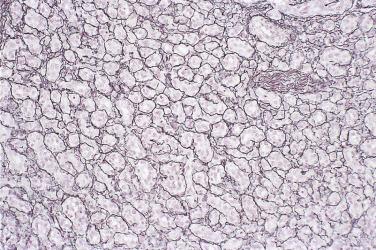
These tumors have a unique immunophenotype that is shared by placental microvessels and is characterized by expression of glucose transporter 1 (GLUT1) and Lewis Y (LeY) antigen. GLUT1, the erythrocyte-type glucose transporter protein, is expressed in these lesions at all stages of their evolution. Because GLUT1 is not expressed in other vascular tumors usually occurring in children, expression of this marker is a valuable aid in differential diagnosis, particularly in the setting of vascular malformations, which do not express this marker. Similarly, WT-1 seems to be expressed in hemangiomas and not malformations. Studies have suggested that these lesions are composed, at least in part, of CD133-positive endothelial progenitor cells. In addition, juvenile capillary hemangiomas have been shown to be clonal. Histologically, RICH often overlaps with capillary hemangioma. It involves the dermis and subcutis and consists of lobules of congested, slightly dilated capillaries, each of which is surrounded by a layer of pericytes. Between tumor lobules fibrosis, dystrophic calcification, and hemosiderin deposition occur with few scattered larger, feeding blood vessels. Perineural extension is not usually seen. Late lesions can display intralobular fibrosis. As opposed to classic examples of capillary hemangioma, GLUT1 is negative or very focally positive in most cases.
NICH tumor lobules display more variation in size, and although capillaries predominate, larger blood vessels are seen both within and outside the lobules. These vessels have features of arteries and veins. Arteriovenous fistulae can be seen. Many of these features are like those seen in vascular malformations. GLUT1 staining is usually negative.
It is important to highlight that distinction between the different entities described on histologic grounds only is often not possible and close clinicopathologic correlation is therefore necessary to reach a diagnosis.
Tufted angioma is a distinctive benign vascular tumor closely related to capillary hemangioma. Although it was first recognized as an entity in the English literature in 1976, identical cases had been described in the Japanese literature since 1949 under the name angioblastoma.
Clinically, tufted angioma presents as an acquired lesion, most often on the neck or trunk of small children but rarely at mucosal sites ; no sex predilection is seen. Rare cases can occur in adults. Congenital presentation is seen in a small number of cases. Multifocal lesions are very rare. Isolated familial cases have been described. Lesions progress slowly over years as ill-defined red or brown macules, papules, and nodules, which are commonly tender. Spontaneous regression has been reported in some cases. Although the clinical course is benign, complete excision is not usually possible because of the extensive nature of the disease process. Furthermore, local recurrence beyond the apparent disease margin is quite common. Rarely, the Kasabach-Merritt syndrome may occur and this and a number of overlapping histologic features indicates a close relationship with kaposiform hemangioendothelioma (see later discussion). It is most likely that tufted angioma represents a smaller variant of kaposiform hemangioendothelioma, more frequently presenting in the skin and less commonly associated with complications such as Kasabach-Merritt syndrome. Exceptionally, a low-grade coagulopathy is seen. Association with a vascular malformation has also been documented.
The cardinal feature of tufted angioma is the presence of scattered round or ovoid lobules of closely packed capillaries in the dermis and superficial subcutis in a typically discohesive cannonball-like distribution ( Fig. 3.7 ). Individual lobules are very similar to those seen in the early stages of strawberry nevus and consist of varying proportions of poorly canalized bloodless capillaries surrounded by pericytes. The endothelial cells are bland, and mitotic figures are rare. Focally, cytoplasmic crystalline inclusions can be seen in the endothelial cells. The nature of these inclusions is unknown. A distinctive feature is the presence of dilated, crescent-shaped, lymphatic-like vascular channels at the periphery of some of the tumor lobules. Intravascular location has been described, and histologic overlap exists between kaposiform hemangioendothelioma and tufted angioma, further suggesting a spectrum between both tumors.
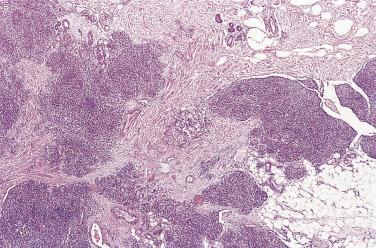
A common source of confusion is nodular Kaposi sarcoma (KS), from which tufted angioma is easily distinguished by its cannonball-like pattern, lack of a significant spindle cell population, and negativity for HHV-8.
Cherry angiomas are very common and present as red papules on the trunk and upper limbs of middle-aged and elderly adults. They increase in number with age and are characterized histologically by dilated and congested capillaries, with a lobular architecture, situated in the papillary dermis. HRAS and KRAS mutations have been demonstrated in a small number of lesions.
Pyogenic granuloma is a very common vascular lesion of the skin and mucous membranes, which for many years was considered to be a reactive or infective process. This was based on the presence of extensive superficial secondary inflammatory changes (due to frequent ulceration) and an apparent association with trauma in up to a third of cases. The underlying process, however, is a neoplastic lobular vascular proliferation, which has deep and intravascular counterparts (see upcoming discussion), and has been redesignated, appropriately, as lobular capillary hemangioma. Lesions can appear at any age, in either sex, and with special predilection for the fingers and head and neck area, especially the nasal and oral mucosae. Other mucosal surfaces including genital mucosa may be involved. Presentation in the gastrointestinal tract (esophagus, stomach, small and large bowel, liver and common bile duct), larynx, and trachea is exceptional. Congenital lesions have been described rarely. The classical appearance is that of a solitary, rapidly growing, ulcerated, bleeding, polypoid blue-red nodule that is usually less than 2 cm in diameter. Rare cases of disseminated (eruptive) pyogenic granuloma have been reported. Some of these cases have exceptionally been associated with a drug hypersensitivity reaction, a landmine injury, a burn, or an acquired arteriovenous malformation. Complete spontaneous regression does not occur, and local recurrence is seen in up to 10% of cases, especially after incomplete excision. This is especially notable in lesions of the nasal septum. An unusual phenomenon, which tends to develop mainly on the trunk of children and young adults, is recurrence characterized by multiple sessile nodules (satellitosis). Lobular capillary hemangioma may rarely occur within port-wine stains, and pyogenic granuloma-like lesions have been described in association with therapy with capecitabine, topical tretinoin, isotretinoin, gefitinib, 5-fluorouracil, erythropoietin, BRAF inhibitors including vemurafenib and encorafenib, with EGFR tyrosine kinase inhibitors, levothyroxine, and anti-TNF-alpha. Lesions have also been documented in association with pulse dye laser, after hydroxyapatite implants, in an intraoral location after bone marrow transplant in children and adolescents, and as multiple recurrent lesions in a patient with neurofibromatosis type 1 (NF1) and von Hippel-Lindau syndrome.
Most lesions are exophytic, ulcerated, and surrounded by an acanthotic epidermal collarette. Near the surface, if ulcerated, a prominent acute inflammatory cell infiltrate and exuberant, often edematous granulation tissue develops, but the core of the tumor shows lobules of small capillaries, with or without discernible lumina, lined by prominent endothelial cells ( Fig. 3.8 ). The stroma is loose and edematous, and normal mitotic figures can be numerous, especially in mucosal lesions ( Fig. 3.9 ). Moderate reactive cytologic atypia can be present, especially in lesions arising in the mouth and conjunctiva; such atypia is often most striking adjacent to an ulcerated surface. Rarely, epithelioid endothelial cells are seen focally lining the vascular spaces. Older lesions can show marked fibrosis. The resemblance to granulation tissue is lost in deep or intravascular lesions. Satellite nodules show similar histologic findings with involvement of the reticular dermis and even the subcutis. Immunostaining with actin highlights a layer of pericytes surrounding each individual blood vessel. Exceptional cases may display extramedullary hematopoiesis.
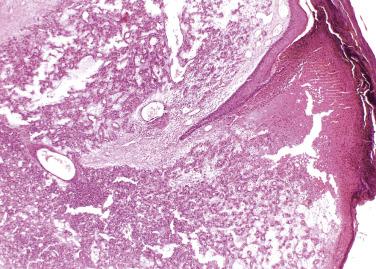

A recent study has found evidence of human papillomavirus type 2 in 44% of cases of lobular capillary hemangioma by polymerase chain reaction (PCR), suggesting a possible etiologic link.
Somatic activating RAS mutations have been described in sporadic lobular capillary hemangiomas. More recently, BRAF mutations, particularly BRAF c.1799>A and less commonly RAS mutations, have been found in a percentage of tumors developing within port-wine stains and with less frequency in sporadic lobular capillary hemangiomas, suggesting a role for the RAS pathway in their pathogenesis.
Granuloma gravidarum refers to identical lesions occurring in the gingivae of pregnant women; these usually involute after delivery. Subcutaneous pyogenic granuloma presents as an asymptomatic nodule, mainly in the upper limb, and shows identical histologic features without the secondary changes associated with classical pyogenic granuloma. Intravenous pyogenic granuloma is a rare variant presenting predominantly in adults, especially in the neck and upper extremity. Secondary inflammatory changes are not seen, and the clinical behavior is benign.
The traditional differential diagnosis is from well-differentiated angiosarcoma and nodular KS. In the first, usually poor circumscription, cellular atypia, and dissection of collagen bundles occur. In the second, invariably a prominent spindle cell component occurs with formation of slitlike spaces. The main differential diagnosis in recent years has been with bacillary angiomatosis , an infectious vascular proliferation caused by a gram-negative organism, Bartonella henselae (formerly Rochalimaea henselae ) and much less commonly by Bartonella quintana . This condition occurs almost exclusively in patients with acquired immunodeficiency syndrome (AIDS) or other immunosuppressive conditions and rarely in normal individuals. Its recognition is important because of the dramatic response to antibiotic therapy, especially erythromycin. The incidence of this condition has diminished dramatically initially because of the sensitivity of the causative organism to the prophylactic antituberculous treatment routinely received by human immunodeficiency virus (HIV)–positive individuals and later because of the introduction of antiretroviral therapy. The architecture of both conditions is very similar, the main difference being the presence in bacillary angiomatosis of pale epithelioid endothelial cells, focal cytoplasmic vacuolation, clusters of polymorphs with leukocytoclasis throughout the lesion, and granular basophilic or amphophilic material in relation to the inflammatory cells ( Fig. 3.10 ). When stained with Warthin-Starry or Giemsa this material is shown to contain aggregates of short bacilli.
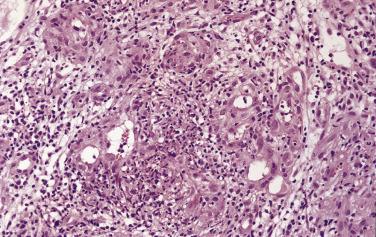
Verrucous venous malformation, previously known as verrucous hemangioma, usually presents as a warty blue-black lesion on the lower extremities of children. Because of its warty appearance, clinical misdiagnosis is not uncommon. Histologically, most lesions consist of numerous dilated capillaries and occasional cavernous-like vascular spaces in the superficial dermis, extending into the deep dermis and subcutaneous tissue ( Fig. 3.11 ). Overlying epidermis shows very marked acanthosis and hyperkeratosis. The endothelial cells in the proliferation express an incomplete lymphatic phenotype and are often positive for GLUT1. WT1 is consistently negative supporting the reclassification as a malformation. A somatic MAP3K3 mutation has been described. Wide excision is necessary to avoid local recurrence, which is common. Although verrucous hemangiomas have a superficial resemblance to angiokeratomas, the latter represent vascular ectasias, involve only the papillary dermis, and are cured by simple excision.

Although less common, cavernous hemangioma has the same age, sex, and anatomic distribution as capillary hemangioma. As opposed to capillary hemangioma, however, these lesions tend to be larger, deeper, and less well circumscribed; very few, if any, show a tendency to regress. Virtually any organ in the body can be affected by cavernous hemangioma. Associated clinical syndromes include Maffucci syndrome with multiple enchondromas, occasional lymphangiomas, and often spindle cell hemangiomas; Kasabach-Merritt syndrome with consumption coagulopathy ; and blue rubber bleb nevus syndrome with numerous hemangiomas in the skin and gastrointestinal tract.
Cavernous hemangiomas consist of poorly circumscribed, irregularly dilated blood vessels lined by flat endothelium and with walls of varying thickness ( Fig. 3.12 ). Areas resembling capillary hemangioma can often be found focally, especially in the superficial portion, and many lesions represent combined capillary and cavernous hemangiomas. Thrombosis, secondary dystrophic calcification, and mild inflammation are frequently found.

Sinusoidal hemangioma is a more distinctive variant of cavernous hemangioma. It has a wide anatomic distribution with special predilection for the subcutaneous tissue of the breast. In this anatomic location it can be confused with angiosarcoma. Most lesions occur in middle-aged adults, predominantly women, as a superficially located blue nodule. Simple excision is curative.
Typically, lesions are lobular, relatively circumscribed, and composed of irregular, dilated and congested, thin-walled gaping blood vessels with a typical sinusoidal or sievelike appearance ( Fig. 3.13 ). Cross-sectioning of back-to-back blood vessels with little intervening stroma results in prominent pseudopapillary structures reminiscent of Masson tumor. The vascular spaces are lined mainly by an attenuated monolayer of endothelial cells, which can be focally prominent with mild reactive nuclear hyperchromasia. An outer layer of actin-positive pericytes can also often be discerned. As in ordinary cavernous hemangioma, thrombosis with dystrophic calcification is commonly seen, and this may be the cause of abnormality on mammographic screening. Rarely, central infarction is present. Old lesions show fibrosis and hyalinization of blood vessels.
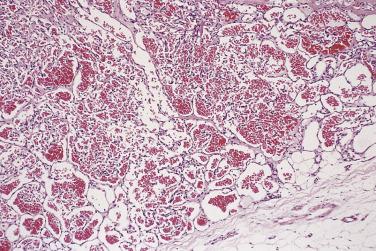
The main differential diagnosis is from well-differentiated angiosarcoma, especially in lesions occurring in the breast. Mammary angiosarcoma is intraparenchymal, rather than dermal or subcutaneous, and shows a clearly infiltrative or dissecting pattern with at least focal nuclear atypia and hyperchromasia. Sinusoidal hemangioma shares some histologic features with anastomosing hemangioma, a tumor with predilection for the genitourinary tract and paraspinal soft tissue.
Arteriovenous hemangioma (arteriovenous malformation) is an uncommon lesion. It is divided into two distinctive variants according to the depth of involvement. The deep type usually presents in the head and neck or limbs of adolescents and young adults and can be associated with severe degrees of arteriovenous shunting and soft tissue hypertrophy. These deep lesions probably represent congenital malformations. Symptoms can be severe, and patients may present with heart failure or Kasabach-Merritt syndrome. Clinicopathologic correlation, including arteriographic studies, is very important in establishing the diagnosis. Persistent growth and symptoms are common after incomplete excision. These lesions are often associated with RASA1 mutations.
The superficial type, which is also known as cirsoid aneurysm or acral arteriovenous tumor, typically presents in the skin of the head and neck (especially the lip) of middle-aged or elderly adults (often men) as a small red-blue papule. A variant presenting on the digits has been documented. Some cases have been associated with chronic liver disease. Symptoms are minimal and include pain and intermittent bleeding. Shunting is not usually a major feature. Superficial cutaneous changes associated with deep arteriovenous hemangiomas can mimic KS clinically and histologically and have been named pseudo-KS or acroangiodermatitis. However, similar changes can be associated with any cause of venous insufficiency.
The histologic features are variable, especially in the deep variant of arteriovenous hemangioma. Superficial lesions tend to be better circumscribed than deep lesions. Both variants are said to show a mixture of thick-walled and thin-walled blood vessels that correspond to arteries and veins of varying caliber with a predominance of the latter ( Fig. 3.14 ), as can be demonstrated by the use of elastic stains ( Fig. 3.15 ). Focally, some tumors can resemble capillary or cavernous hemangiomas. Serial sections are helpful in demonstrating arteriovenous anastomosis. Focal thrombosis and stromal calcification are sometimes seen. In reality, convincing demonstration of arteries in superficial lesions is often very difficult. Conceivably these vessels can represent arterialized veins, and it is likely that many superficial lesions are true venous hemangiomas. In rare cases prominent symplastic changes may be seen mimicking malignancy.
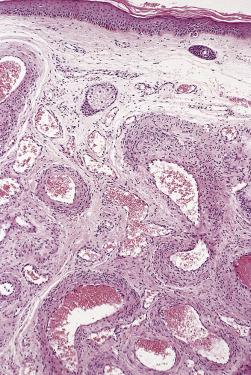

Become a Clinical Tree membership for Full access and enjoy Unlimited articles
If you are a member. Log in here